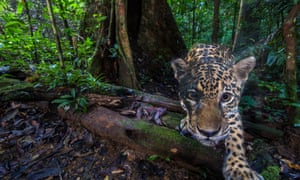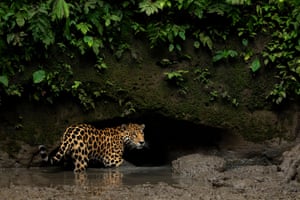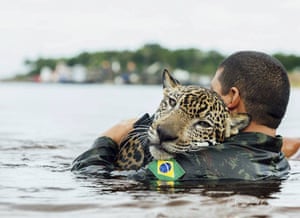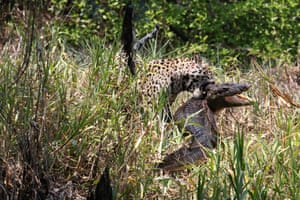
The Guardian
Environment
Kimberley Brown
11 de noviembre de 2019
Across the American continent, from the north of Mexico to Argentina, the jaguar has long been revered for its strength and power. But in some parts of Ecuador, the largest cat in South America is increasingly at risk as roads, mining and agriculture take over the rainforests.
The loss of habitat is the biggest threat to jaguars in Ecuador, particularly along the coast, where more than 70% of the original forest cover has been lost. The vast majority of this destruction has taken place over the last 50 years with the expansion of the logging and agriculture industries, including coffee, cacao, palm oil and bananas, one of the country’s largest agriculture exports.
The coastal jaguar population has been declared critically endangered by the International Union for Conservation of Nature (IUCN). Galo Zapata-Ríos, science director at the Wildlife Conservation Society Ecuador, says only a few remain in one small area on the coast, in the Cotacachi-Cayapas national park, in the northern province of Esmeraldas.
“Jaguars historically were distributed along all the Ecuadorian coast, but now they’re only in Esmeraldas,” says Zapata-Ríos, who has been studying the big cat for 10 years. “That’s the consequence of the advancement of human activity.”
As one of the largest predators in Latin America, the jaguar is essential to maintaining equilibrium in rainforest ecosystems. If it disappears, everything below it in the food chain is affected, with an overpopulation of rodents – the jaguar’s prey – that would eat more bugs and seeds, and decrease the regeneration of trees and other plants in the forest, says Zapata-Ríos.

“That’s why it’s so important – it’s a species that allows you to conserve other species,” says Jessica Pacheco, an endangered species expert with the World Wildlife Fund Ecuador.
Pacheco works predominantly with jaguar conservation initiatives in Ecuador’s Amazon rainforest, where populations are not yet as decimated as on the coast.
A recent study by the WWF estimates that 2,000 jaguars live in the Amazon border region of Ecuador, Colombia and Peru, in what’s known as the Napo-Putumayo corridor, including 21 identified in Ecuador’s Cuyabeno Wildlife Reserve.
Butconservationists are concerned that the expansion of extraction activities in the Amazon will lead to further forest destruction with the creation of roads further into the rainforest, reducing the jaguar habitat and increasing its access to outsiders.
“The moment you open roads, you open a door to a market of wildlife,”says Pacheco.
Over the past two years, the Ecuadorian president, Lenín Moreno, has been actively seeking new oil investment, hoping to attract $800m for four oil fields in the eastern Amazon rainforest. He also plans to double the value of the country’s mining industry by 2021, which includes developing open pit mining in the gold- and copper-rich southern Amazon.

The increase in Chinese investment in the Amazon also has conservationists concerned that this could lead to increased jaguar trafficking, as it opens up easier access to Asian markets. So far, two mines in the southern Amazon, the Mirador and San Carlos Panantza copper mines, are Chinese-owned.
Jaguar trafficking is on the rise across South America, in countries such as Suriname, Peru, Bolivia and Brazil, as its teeth, skin and bones are used in Chinese traditional medicines and exotic jewellery.
While jaguar trafficking is not yet established in Ecuador, the illegal hunting of other bush meat, such as wild boar and watusa, a large rodent, is common. With the jaguar’s natural prey diminishing, it is being forced to eat chickens and dogs from local communities, causing conflict and competition with humans over resources.
“We need to transform conflict into coexistence,” says Pacheco. She believes jaguar conservation can only be achieved by working with communities. “It’s holistic work,” she adds.
Both Pacheco and Zapata-Ríos have developed conservation projects with local communities. These include creating programmes to educate local people about the importance of the jaguar and teaching them how to set up and run camera traps to monitor local populations, she says.

Indigenous communities have historically had strong connections with jaguars and other felines, which were often seen as symbols of strength and divinity. Some of the earliest documented evidence of felines in Ecuador comes in the form of ancient relics and statues that date back 3,000 years, made by pre-Columbian era societies.
“They’re very important,” says Ushigua. If the jaguar disappears, the Sápara nation “would lose all of our knowledge … We would end horribly.”
Conservationists have not yet given up on the jaguar’s future in Ecuador. Even on the coast, Zapata-Ríos says, “The work is a lot harder there, but I’m optimistic that we can still maintain the small population.”
